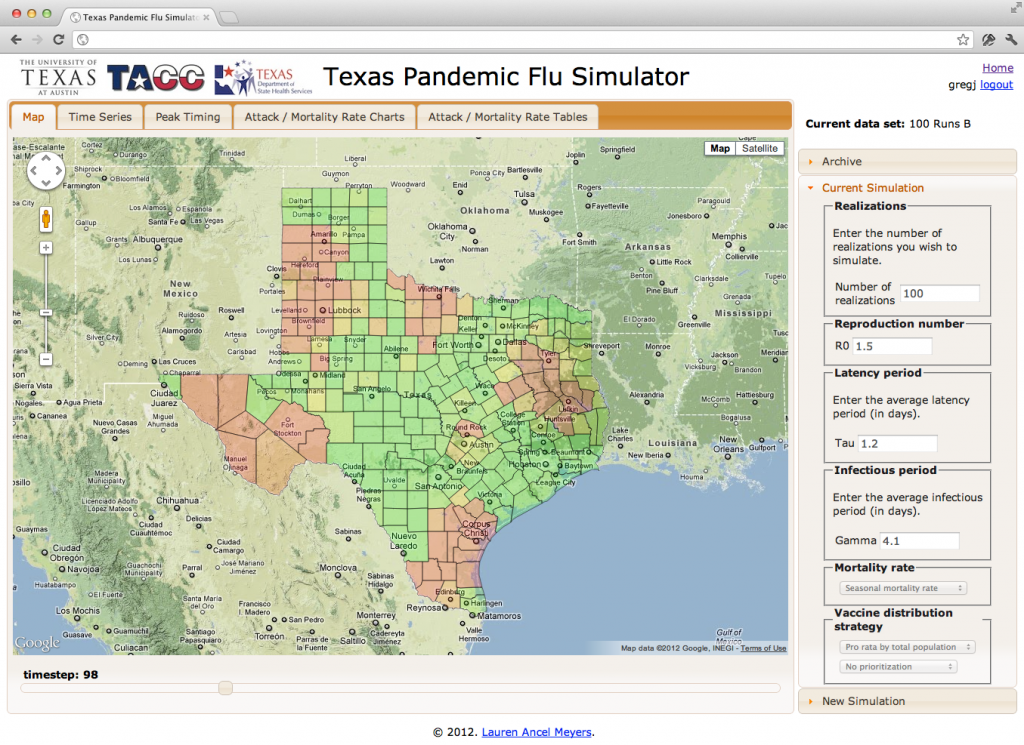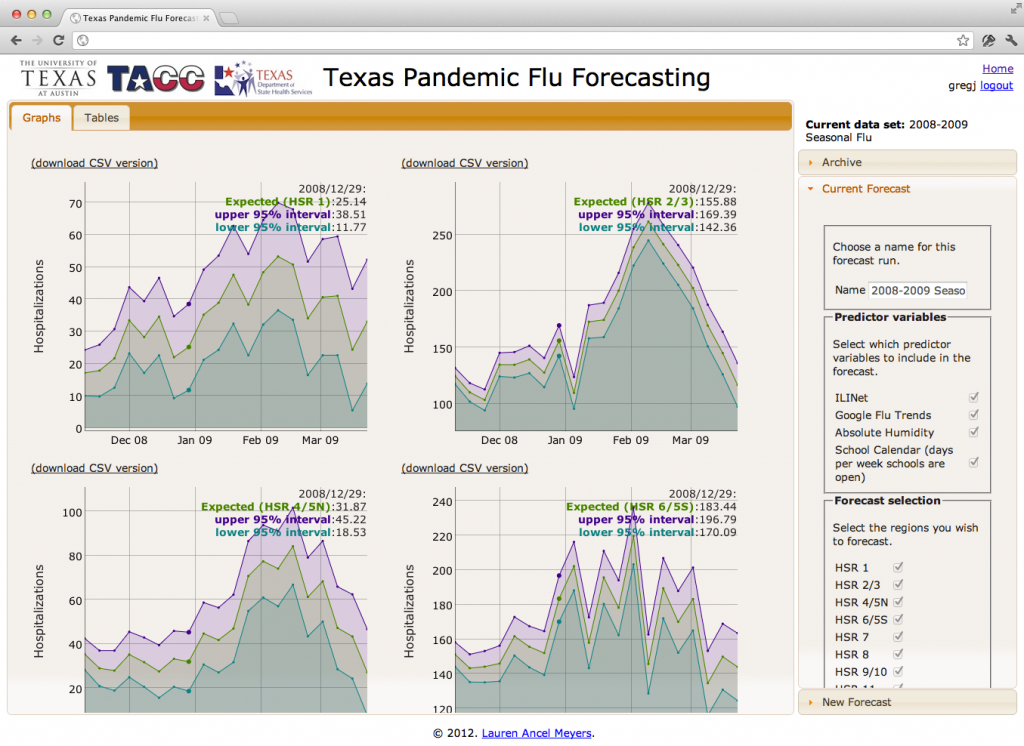A new toolkit, developed by University of Texas researchers, simulates the spread of pandemic flu through the state, enabling public health officials to make decisions in real time.
[Originally published on the website of the Texas Advanced Computing Center]
 The Texas Pandemic Flu Simulator allows for simulation of flu pandemics across the state of Texas under user-defined scenarios. Antiviral, vaccine, and public health announcement interventions are modeled. Results can be interactively visualized.In 2009, the H1N1 "swine flu" pandemic struck, infecting millions and killing more than 18,000 worldwide, according to the World Health Organization. Though less severe than initially feared, the pandemic highlighted the potential threat of deadly viruses emerging from animals into humans, and the importance of quick and effective public health intervention.
The Texas Pandemic Flu Simulator allows for simulation of flu pandemics across the state of Texas under user-defined scenarios. Antiviral, vaccine, and public health announcement interventions are modeled. Results can be interactively visualized.In 2009, the H1N1 "swine flu" pandemic struck, infecting millions and killing more than 18,000 worldwide, according to the World Health Organization. Though less severe than initially feared, the pandemic highlighted the potential threat of deadly viruses emerging from animals into humans, and the importance of quick and effective public health intervention.
In a globalized world, the probability of a severe pandemic striking are high, according to Lauren Ancel Meyers, an expert in infectious disease epidemiology at The University of Texas at Austin. A biologist by training, Meyers applies mathematical models and computer programs to understand, analyze and predict the transmission of diseases based on a large number of factors.
During the H1N1 outbreak, Meyers worked with officials in national and international public health agencies to simulate the spread of the disease based on properties of the flu virus, demographic information, traffic patterns, and other data. Her models illustrated how the disease might spread and how the placement of preventative measures, like vaccines and antivirals, could mitigate the pandemic.
Meyer's efforts to enhance data-driven science were aided by the Texas Advanced Computing Center (TACC), a leading advanced computing center located at the University. Meyers collaborated with TACC staff and used the center's systems to forecast the infections as the pandemic progressed, and to develop visualizations that vividly depicted the spread of the disease.
In 2010, Meyers began discussions with public health authorities at the Texas Department of State Health Services (DSHS) to continue the project. "They were interested in working with us to build quantitative tools to support decision making during pandemics," Meyers said.
Working with a team of UT researchers from biology, mathematics, statistics, engineering and computing, Meyers led the development of the Texas Pandemic Flu Toolkit, a web-based service that simulates the spread of pandemic flu through the state, forecasts the number of flu hospitalizations, and determines where and when to place ventilators to minimize fatalities.
 The Texas Ventilator Stockpiling tool computes optimal solutions for central and regional ventilator stockpiles based on expected peak-week ventilator demands. These demands can either be provided by the user, or imported from the Texas Pandemic Flu Forecasting tool.The toolkit can be used in emergency situations to guide real-time decision-making. For example, public health officials might use the forecaster tool to determine when a pandemic might crest and what kind of magnitude they might see in terms of infections and hospitalizations, which can then be communicated to local authorities.
The Texas Ventilator Stockpiling tool computes optimal solutions for central and regional ventilator stockpiles based on expected peak-week ventilator demands. These demands can either be provided by the user, or imported from the Texas Pandemic Flu Forecasting tool.The toolkit can be used in emergency situations to guide real-time decision-making. For example, public health officials might use the forecaster tool to determine when a pandemic might crest and what kind of magnitude they might see in terms of infections and hospitalizations, which can then be communicated to local authorities.
"While the forecasts will not be exact, they give a rough idea of how many people will be hospitalized around the state and when an epidemic may peak. Such information can lead to more timely and effective control measures," Meyers said.
The toolkit can also be used proactively to develop scenarios of probable pandemics and to see how they may impact different locations, age groups, and demographics. Various interventions, such as antivirals, vaccines, and public health announcements, can be input into the forecasts to determine their effect at different stages in the pandemic's evolution.
Importantly, TACC's powerful supercomputers allow data to be processed, crunched, and distributed to a large number of stakeholders simultaneously.
"Our methods often require rapid evaluation of a large number of possible solutions, which would be intractable without high performance computers," Meyers explained.
Bruce Clements, director of community preparedness with the DSHS, said the project provides Texas with an unprecedented ability for pandemic simulation and forecasting.
"The toolkit allows us to respond more effectively by providing the ability to quickly adjust predictive variables as we gather information. We can use this information to focus response efforts and optimize resources," Clements said. "These same tools may be used in training and exercises to better prepare our public health workforce."
Much of the data that drives the toolkit comes from the Outpatient Influenza-Like Illness Surveillance Network (ILINet). Texas ILINet has 134 enrolled providers who voluntarily report outpatient influenza-like illness by age group to the CDC on a weekly basis. This information is fed into the toolkit and grounds the simulations in real data. Historical information from past pandemics is also included, as are factors like humidity predictions and school calendars, both of which play a large role in the evolution of a pandemic.
David Morton from the UT Cockrell School of Engineering led the Texas ventilator-stockpiling portion of the project. A significant fraction of influenza patients infected during a pandemic require ventilators. Despite the fact that there is a strategic national stockpile of ventilators — about 6,000 — no one knows whether it is right-sized under a variety of different scenarios.
 The Texas Pandemic Flu Forecasting tool predicts hospitalizations regionally and state-wide based on various indicators including ILI surveillance data, Google flu trends, absolute humidity and school calendar data.The tool takes information from the forecaster and projects where ventilators should be optimally placed to limit mortality. In essence, it provides the best solution to a bad situation.
The Texas Pandemic Flu Forecasting tool predicts hospitalizations regionally and state-wide based on various indicators including ILI surveillance data, Google flu trends, absolute humidity and school calendar data.The tool takes information from the forecaster and projects where ventilators should be optimally placed to limit mortality. In essence, it provides the best solution to a bad situation.
"If we have a mild or moderate pandemic then we have ample ventilators. But if we have a severe pandemic, then we're grossly short," Morton said. "Officials knew that, but the thing they valued here was that we could actually quantify how short are we."
In the case of a pandemic, Texas would need all 6,000 ventilators; ten times as many would be required nationwide.
Meyers, Morton, and UT graduate students, Tom Hladish and HsinChan (Neo) Huang, developed the domain-specific aspects of the toolkit. However, it was TACC research associate, Greg P. Johnson, who translated the researchers' algorithms into a web-based interface that provides information-rich data visualizations directly to a user's desktop.
"Greg did a phenomenal job of translating our ideas into extremely user-friendly and transparent tools that surpassed all of our expectations," Meyers said.
Meyers and company unveiled the toolkit to DSHS officials in late 2011. Since that time, public health officials in Texas have been able to log on to the portal, enter a series of parameters, and receive clear and dynamic maps, graphs, and charts showing the results based on various conditions and inputs.
Meyers continues to meet with the CDC and the Texas DSHS to discuss ideas for extending the toolkit.
"These tools are designed to be accessible and to help officials make more quantitatively grounded policy decisions," Meyers said. "The user friendly web-based interfaces help to translate basic science into practical inputs for public health preparedness and response."
Data-driven science is a big deal these days. Recently, the U.S. government committed hundreds of millions of dollars toward enabling new applications that can harness data streams effectively. The Texas Pandemic Flu toolkit shows how this new paradigm will affect public health decision-making. For now, it remains one of the few pandemic-fighting tools available to public health officials.
Said Meyers: "We've just scratched the surface in terms of developing quantitative tools that improve our ability to track and control infectious disease outbreaks."


















Comments